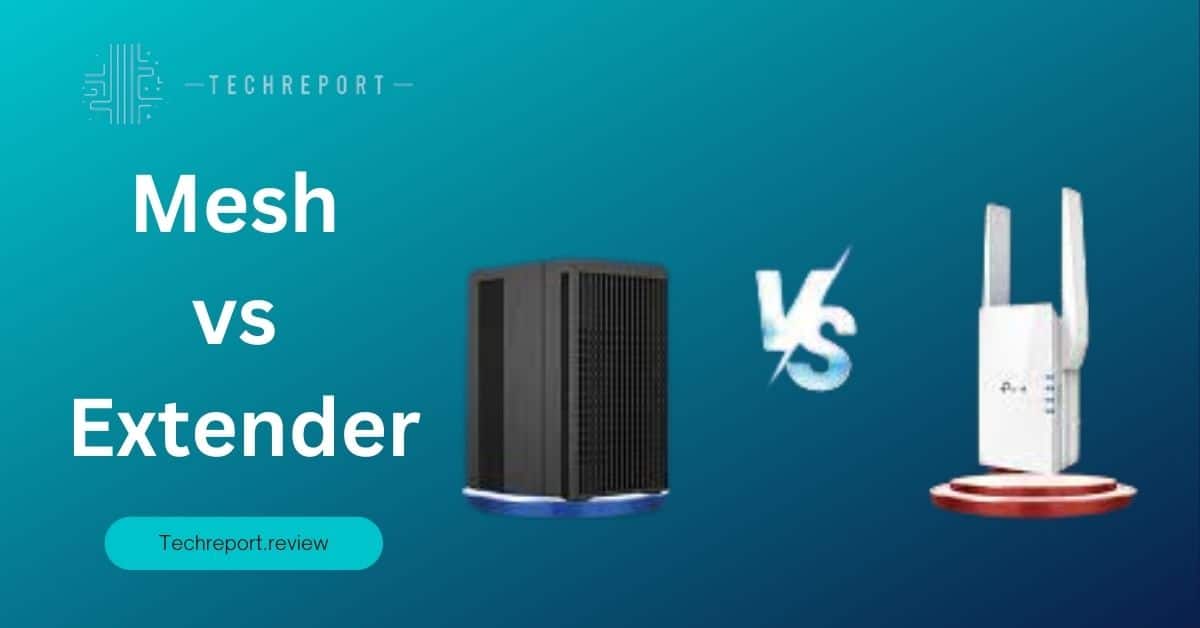Mesh and extender are two terms that are commonly used in the world of wireless internet connectivity. A mesh network is a network that uses multiple nodes or devices to provide coverage over a large area. Each node in the network communicates with the other nodes, creating a seamless network with no dead zones. On the other hand, an extender is a device that is used to extend the range of an existing wireless network by receiving and retransmitting the signal from a base router.
In today’s world, Wi-Fi connectivity is essential for both personal and professional use. With the increasing number of devices that require an internet connection, it’s becoming more important to have a reliable and fast Wi-Fi network. Wi-Fi connectivity is not just limited to homes and offices, but it’s also essential for public places like cafes, hotels, and airports. With the rise of remote work and online learning, having a strong Wi-Fi connection has become a necessity.
The purpose of this article is to compare and contrast mesh and extender technologies, and to help readers make an informed decision on which technology best suits their needs. This article will provide a comprehensive overview of the pros and cons of both mesh and extender technologies, and will also discuss the differences in coverage, performance, and cost. By the end of this article, readers will have a better understanding of which technology is the best choice for their specific Wi-Fi needs.
Mesh vs Extender

When it comes to extending Wi-Fi coverage, there are two main options available: Mesh networks and Wi-Fi extenders. A Wi-Fi extender, also known as a range extender, is a device that is used to extend the coverage area of an existing Wi-Fi network. A mesh network, on the other hand, is a network of devices that work together to provide seamless Wi-Fi coverage throughout a home or office. The key difference between these two options is the way they extend Wi-Fi coverage.
A Wi-Fi extender works by receiving the existing Wi-Fi signal from a router and then rebroadcasting it to extend the coverage area. The problem with this approach is that the signal from the extender is typically weaker than the original signal, resulting in slower internet speeds and potentially unreliable connections.
A mesh network, on the other hand, consists of multiple devices, or nodes, that work together to create a seamless Wi-Fi network. Each node acts as a separate access point, providing a strong Wi-Fi signal throughout the coverage area. This means that the signal is not weakened as it is transmitted from one device to another, resulting in faster internet speeds and a more reliable connection.
The main difference between Mesh Wi-Fi and a Wi-Fi extender is the way they handle network traffic. In a traditional Wi-Fi network, all traffic is sent and received through a single router. This can result in congestion and slow speeds, especially if there are many devices connected to the network.
With a mesh network, each node acts as a separate access point, providing a dedicated connection for devices in that area. This means that the network can handle more devices without slowing down and can provide better coverage throughout the entire area. Additionally, mesh networks can automatically route traffic between nodes to ensure that each device is connected to the strongest signal.
Wi-Fi extenders, on the other hand, simply rebroadcast the existing signal from the router, resulting in a weaker and potentially unreliable connection. Extenders can also create a separate network name (SSID), which can cause confusion for users trying to connect to the network.
Pros and Cons of Mesh and Extender
| Mesh Wi-Fi | Wi-Fi Extenders | |
|
Pros |
Seamless coverage throughout the entire coverage area | Can extend the coverage area of an existing network |
| More reliable and faster internet speeds | Weaker and potentially unreliable connection | |
| Ability to handle more devices without slowing down | Easy to install and set up | |
| Automatic routing of traffic between nodes | ||
| Easy to set up and manage through a mobile app | ||
| More expensive than Wi-Fi extenders | ||
|
Cons |
May require additional nodes to cover larger areas | Inexpensive compared to mesh networks |
| Nodes need to be placed strategically to ensure optimal coverage | Can create confusion with multiple network names (SSIDs) | |
| May require additional configuration to ensure seamless coverage |
In terms of reliability, Mesh Wi-Fi is generally considered to be the better option. Mesh networks provide seamless coverage throughout the entire area, resulting in faster speeds and a more reliable connection. Additionally, mesh networks can automatically route traffic between nodes to ensure that each device is connected to the strongest signal.
Wi-Fi extenders, on the other hand, rely on the existing Wi-Fi signal from the router, which can result in a weaker and potentially unreliable connection. Extenders can also create a separate network name (SSID), which can cause confusion for users trying to connect to the network.
Mesh vs Extender: Coverage
When it comes to coverage, a mesh network generally provides better coverage than an extender. A mesh network consists of multiple nodes or access points that work together to create a single, seamless Wi-Fi network. Each node communicates with the others, allowing devices to connect to the closest node, regardless of their location. This creates a continuous network with no dead zones.
On the other hand, an extender is a device that receives the existing Wi-Fi signal from your router and rebroadcasts it to extend its range. While this can increase the range of your Wi-Fi network, it can also lead to performance issues, such as slower speeds or dropped connections, as the signal is being transmitted over a greater distance.
A mesh network provides better coverage by using multiple access points, or nodes, strategically placed throughout your home or office. Each node communicates with the others to create a seamless Wi-Fi network with no dead zones. This means that you can move from room to room without losing your connection or experiencing any drops in speed.
Mesh networks also use advanced algorithms to optimize the connection between each node and your device, ensuring that you always have the best possible connection. This is particularly useful in larger homes or offices where a single Wi-Fi router may not be enough to provide adequate coverage.
While an extender can help to increase the range of your Wi-Fi network, it may not be able to provide the same coverage as a mesh network. This is because an extender simply rebroadcasts the existing Wi-Fi signal, which can lead to performance issues such as slower speeds or dropped connections.
Additionally, an extender may not be able to provide coverage to areas that are too far away from the original router, as the signal may become too weak to be effectively extended. In contrast, a mesh network can be expanded by simply adding additional nodes to provide coverage to even the most remote areas of your home or office.
Mesh vs Extender: Performance
Mesh systems are designed to provide seamless coverage throughout the home or office, eliminating dead zones and ensuring that every device has a strong and reliable connection. Unlike extenders, which can cause a degradation in performance as they relay signals from the router, mesh networks work by creating a single, unified network that utilizes multiple access points.
While an extender can be an effective solution for improving coverage in a specific area, it cannot replicate the seamless coverage provided by a mesh network. Therefore, a mesh system can replace an extender in most cases.
Latency is the delay that occurs when data is transmitted over a network. In general, a mesh network can provide lower latency than an extender. This is because mesh systems use multiple access points to distribute traffic evenly, reducing the likelihood of bottlenecks and congestion.
In contrast, extenders can introduce additional latency due to the extra hop required to relay data. Therefore, a mesh network can be a better option for applications that require low latency, such as online gaming and video conferencing.
Mesh and extender technologies both have their strengths and weaknesses when it comes to performance. Mesh networks are generally considered to be more robust and reliable, offering seamless coverage and better throughput than extenders.
On the other hand, extenders can be a more affordable option for improving coverage in a specific area. However, they can also cause a degradation in performance, particularly if the extender is placed too far from the router.
Overall, the best option for improving Wi-Fi performance will depend on the specific needs of the user, as well as the layout and size of the home or office.
Network topology refers to the way in which devices are interconnected on a network. The topology of a network can have a significant impact on the performance of both mesh and extender systems.
For example, mesh networks are designed to work best when access points are placed in a way that allows them to communicate with each other effectively. In contrast, extender performance can be impacted by the distance between the extender and the router, as well as the quality of the signal.
Therefore, when setting up a mesh or extender system, it is important to consider the network topology and ensure that access points are placed in a way that optimizes performance. This may involve experimenting with different configurations and locations to find the best setup for a specific home or office.
Mesh vs Extender: Connectivity
When it comes to bandwidth, both Mesh and Extender have their limitations. Mesh networks use multiple nodes to distribute the load and ensure that each device receives an equal amount of bandwidth. The more nodes you have, the more bandwidth you can distribute across your devices.
However, adding too many nodes to the network can also cause congestion and slow down the entire network. On the other hand, extenders can boost the Wi-Fi signal, but the bandwidth remains the same as the original network. This means that an extender can only increase the range of your network, but not the speed or the bandwidth.
In terms of signal strength, both Mesh and Extender have their benefits. Mesh networks use multiple nodes to distribute the Wi-Fi signal throughout your home or office. This means that you get a stronger and more reliable signal, regardless of where you are in the building. Extenders, on the other hand, can boost the signal of an existing network, but they can also degrade the signal quality due to signal loss during transmission. In general, Mesh networks provide a more consistent and reliable signal throughout your home or office.
Yes, you can use an Extender with a Mesh Network. However, it is not recommended as it can create complicated network topology and lead to more signal loss and congestion. If you need to extend the coverage of your Mesh Network, it is better to add another node instead of using an Extender.
There are many brands that offer Mesh and Extender options, but some of the most popular and reliable brands are:
Mesh Networks
- Google Nest Wifi
- Amazon Eero Pro
- Netgear Orbi
- TP-Link Deco
Extenders
- Netgear Nighthawk X4 AC2200
- TP-Link AC1750
- Linksys RE7000
- D-Link DAP-1720
These brands offer a wide range of options that cater to different needs and budgets. It is essential to consider factors such as coverage, performance, and connectivity before selecting a Mesh or Extender option.
Mesh vs Extender: Setup and Cost
Setting up a Mesh Network or Extender is relatively straightforward, and most manufacturers provide easy-to-follow instructions. A Mesh Network typically comes with a router and a few nodes or access points. The router needs to be connected to the modem, while the nodes need to be placed strategically around the house to ensure optimal coverage. Once the hardware is set up, users can configure the Mesh Network using a smartphone app or web-based interface.
Extenders, on the other hand, are much simpler to set up. Users need to plug in the extender to an electrical outlet and connect it to their existing Wi-Fi network using a smartphone app or web-based interface. The extender then amplifies the existing signal, providing better coverage.
Mesh Networks are generally more expensive than Extenders. A basic Mesh Network kit with a router and two nodes can cost anywhere between $200 to $400, while more advanced kits can cost up to $500. Additional nodes can also be purchased separately, and their cost can range from $80 to $150 per node.
Extenders, on the other hand, are relatively cheap and can cost between $30 to $100, depending on the features and brand.
Upgrading from an Extender to a Mesh Network can be worth it if the user needs better coverage and higher performance. A Mesh Network can provide seamless coverage across the entire house, while an Extender may cause issues such as signal degradation and latency. Moreover, a Mesh Network can support multiple devices simultaneously without compromising on speed or bandwidth, which may not be the case with an Extender.
However, if the user has a small house or apartment and is satisfied with the existing coverage, there may not be a need to upgrade to a Mesh Network. An Extender can provide the necessary coverage and performance in such scenarios.
In Crux
Both Mesh and Extender are devices that help extend Wi-Fi coverage. Mesh systems use multiple nodes to create a seamless network that provides better coverage and performance, while extenders use a single node to repeat the existing Wi-Fi signal. Mesh networks are generally more reliable, offer better coverage and performance, and are more flexible than extenders. However, extenders can still be a viable option for those on a budget or with smaller spaces to cover.
The answer to this question depends on your specific needs. If you have a larger space to cover, need better performance and coverage, and have the budget to invest in a Mesh system, then it is the better option. However, if you have a smaller space and are on a budget, then an extender may be sufficient.
Wi-Fi connectivity has become an essential part of our lives, and having a reliable and strong signal is critical. Mesh and Extender devices are great options to improve your Wi-Fi coverage and signal strength. When choosing between the two, it is essential to consider your needs, budget, and space to cover. Overall, Mesh systems offer better performance, coverage, and reliability, making them the better choice for most situations.
How much did you like our detailed Unleashing the Power of Wi-Fi: Mesh vs Extender? Also, please share these Blogs with your friends on social media.
Related Blogs
- Is iPhone 14 Worth the Hype
- Unblock Banned Apps
- Best Cheap VPN Services
- Antenna vs Cable TV
- TiVo or DVR
- WiFi and Internet
- Apple Vision Pro
[WPSM_AC id=1219]

























